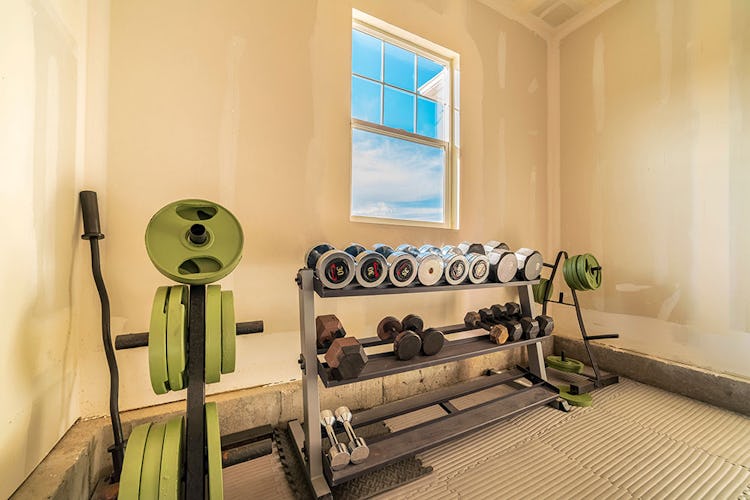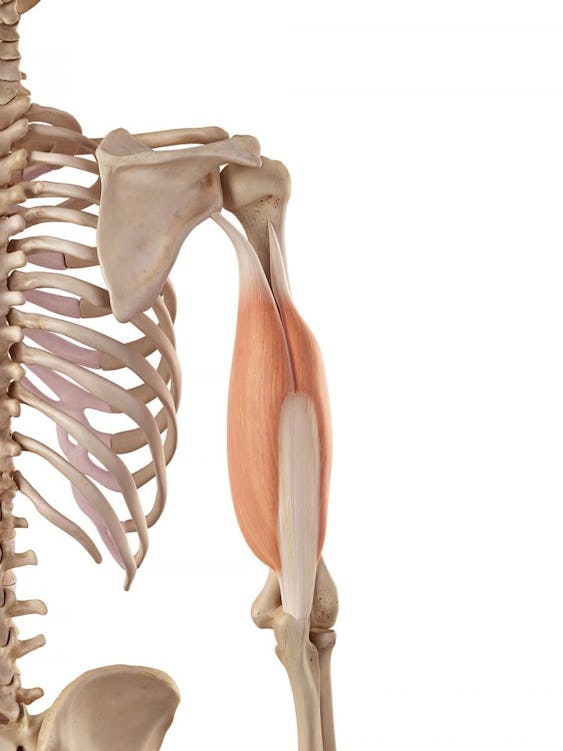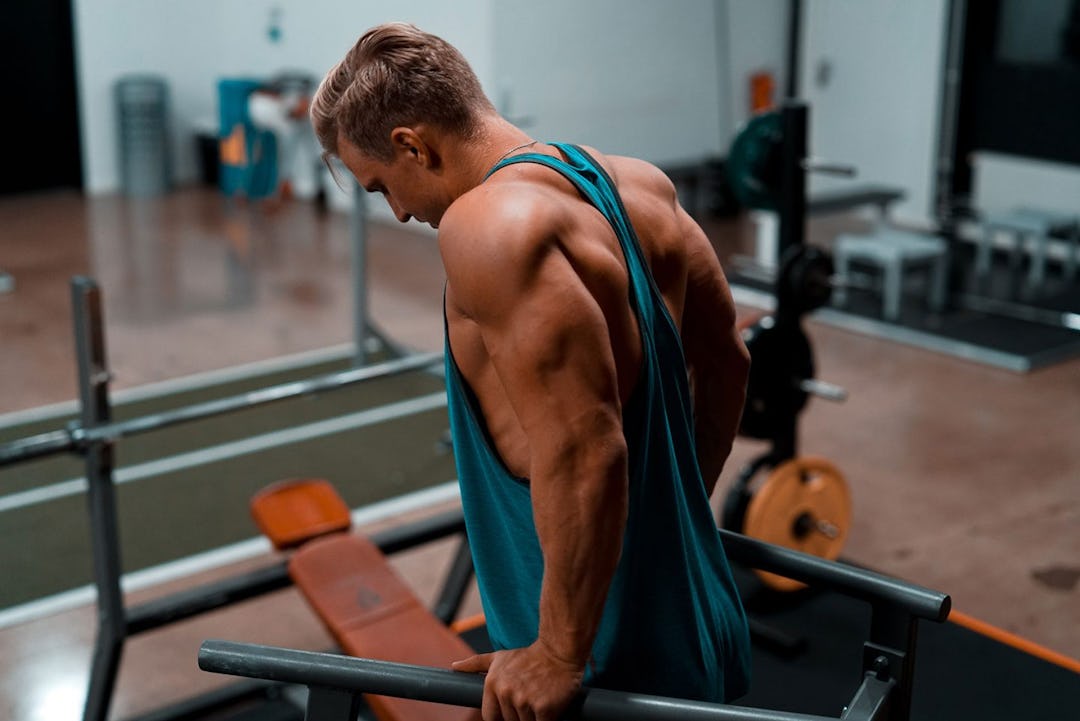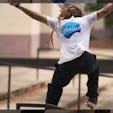Summary
– The triceps consist of three parts—the long, lateral, and medial heads. In addition to locking out the elbows as the other two heads do, the long head also assists with shoulder extension and humeral adduction (drawing the arm down toward the body).
– Triceps need to be trained with compound movements, exercises that start from the stretched position, and moves that emphasize an isometric contraction.
– Included here are stretches for the triceps, and three workouts designed according to the training equipment you have available: dumbbells, bands, or no equipment at all.
– Elbow and shoulder injuries can be gotten around by using shortened ranges of motion and relying on isometric exercises.
3 Killer Triceps Workouts You Can Do At Home

Most people have had to reevaluate their training over the past year. If you went from working out in a fully-equipped commercial gym to clanging around a few dusty dumbbells in your garage, you know how difficult it can be to keep up the variety and intensity you’re used to in your workouts. This is certainly true when it comes to training smaller muscles that we like to use cables and machines for—like triceps. You can figure out how to squat, press, and hinge in your home gym, but how are you supposed to hit the long head of your tri’s without a triceps extension rope and a multi-cable jungle gym?
Nevertheless, training at home can be a blessing in disguise. It gets us out of our rut of using the same old exercises we’re comfortable with—exercises that could actually be setting us up for injury—and forces us to explore the possibilities of bodyweight, band, and dumbbell training. If you’re still working your arms at home, and you’re still stumped on how to hit them effectively with the equipment you’ve got, this article may blow your mind¦ and blow up your triceps.
Benefits of Working Out Your Triceps
If you’re looking to fill up your shirtsleeves, don’t make the mistake of overemphasizing biceps training. The triceps account for two-thirds of the mass in the upper arm, so tri training should be your priority. Besides having a sweet horseshoe on the back of your arm that shows how hard you work out, there are some functional advantages to developing the triceps to their potential.
For one thing, they act as major assistants on any pressing lifts you do, helping the pecs and shoulders. (Some powerlifters actually argue that the bench press relies more on triceps strength than it does any other muscle.) A press is only considered complete, technically speaking, when the triceps lock out the elbows. Another reason to train tri’s hard is to develop all-around throwing and pushing strength. Baseball pitching, basketball shooting, volleyball spiking, shot putting and more all require powerful triceps action.
To help you understand why, let’s get clear on what the triceps are and how they work.
The triceps brachii is the large muscle that runs along the backside of the humerus (upper-arm bone) and consists of three portions, called heads.

Long head. This is the innermost part of the muscle. It’s unique among the triceps heads because it originates on the shoulder blade, and that means that it can help extend the shoulder joint and draw the arm in toward the body, as well as extend the elbow.
Lateral Head. The outermost portion of the triceps, the lateral head originates on the humerus and ends at the ulna (forearm bone). It only works to extend the elbow.
Medial head. Though it’s largely obscured by the other two heads, the medial head starts just below the lateral head on the humerus and inserts on the ulna. It helps form the upper part of the triceps’ horseshoe shape and, like the lateral head, works to lock out the elbow.
Fun fact: “Ceps” is a derivative of the Latin term for head, so, when referring to a muscle, bi-, tri-, or quad- will signal the number of separate units in that muscle.
The triceps having three heads means that small details in our training will adjust the amount of tension that’s placed on one head versus another. These can range from the angle of our movement to the type of grip we use on an exercise. It also means, as mentioned in the explanation of the long head’s function, that the triceps are a more nuanced muscle than most people realize, and they don’t just work to extend the elbow. The shoulder extension and humeral adduction component (drawing the arm down) is important to train as well when looking to develop both function and aesthetics. The triceps, in effect, support the humerus in the shoulder joint. With shoulder injuries being so prevalent, and a lack of stability in the shoulder being a common cause, training the triceps’ long head is critical for supporting the rest of your upper-body training.
How Can I Build Strong Tri’s Without Weights?
Most of the classic moves we are accustomed to utilizing to build the triceps require equipment that’s a little on the fancy side—cables, triceps machines, and fixed-weight EZ-curl bars. Those options may offer a wider array of triceps training possibilities, but they aren’t necessarily any more effective than what you can do with your bodyweight alone. Solid tri work comes down to making sure you check off three boxes in your program:
1. Use compound movements
2. Include exercises that start from the stretched position
3. Create isometric tension in the triceps
Here’s what all that means¦
Compound Movements
Aka multi-joint lifts, compound movements are those that involve more than one joint, meaning that they recruit more overall muscle than single-joint isolation moves. Presses and pushup variations qualify here. To put on size, you have to progressively overload a muscle over time, increasing the loads you use and the number of reps you can perform with those loads. Since compound movements use more muscle (it’s OK to involve some muscles other than the triceps when targeting triceps gains, such as the pecs) and allow for heavier loading, they should be the foundation of any training program.
There’s a safety benefit to training compound lifts too. Going heavy on an isolation exercise like a kickback or machine extension puts a high level of stress on the elbow joint. The risk-to-reward ratio isn’t good. Compound movements, however, distribute the stress of the load over multiple joints, taking pressure off the elbow while still loading up the triceps.
Starting from the Stretch
Most exercises don’t begin with the target muscle in a stretched position. We don’t start squats or barbell bench presses from the bottom. But with triceps, you can start with the muscle fully stretched, such as when the arm is overhead and the elbow bent for an overhead extension movement (this can be done with a band when no weights are available). Starting from a stretched position makes the triceps work hard from the very beginning of the exercise, as they have to overcome the mechanical disadvantage of being all stretched out to extend the elbow. For the best triceps development, you need to include some overhead extension work that starts with the muscles on stretch.
Isometric Tension
An isometric muscle contraction occurs when the triceps tense but the arm doesn’t bend or extend, such as at the halfway point of a dip or pushup. Isometrics can also train the triceps’ function as a shoulder stabilizer—a rare thing in muscle-building programs. Including some isometric work in your program ensures well-rounded triceps training that not only pumps up the muscle but helps prevent injury.
How To Stretch Your Triceps
Regularly stretching can give you access to more range of motion, and ultimately add to the lifespan of your training. Use these stretches before and/or after your workout to promote mobility in the triceps and reduce the risk of injury.
Kneeling Bench Stretch
Sets: 3 Time: Hold 30 seconds Rest: 30 seconds
Step 1. Kneel on the floor and rest your elbows on a bench or box. Tuck your tailbone so that your pelvis is perpendicular to the floor, and brace your core. Your body should form a straight line from your head to your hips.
Step 2. From here, sit back into the hips so the arms become extended overhead and you feel a stretch in the triceps. Hold this position with a tall posture.
Banded Overhead Stretch
Sets: 3 (each side) Time: 30 seconds Rest: 30 seconds
Step 1. Stand on one end of an exercise band with your left foot and grasp the other end with your left hand. Draw your left shoulder back and down and brace your core.
Step 2. Raise your arm overhead and allow the band to bend your elbow and gently pull your arm backward to stretch your triceps.
Static Cross-body Stretch
Sets: 3 (each side) Time: 30 seconds Rest: 30 seconds
Step 1. Draw one arm across the front of your body. With the other hand, get a firm grip near the elbow and gently pull the arm tight to the body. To feel it more in your triceps than your shoulder, hold the arm closer to your hand than your elbow.
Triceps Workouts You Can Do At Home With and Without Weights
Do you have dumbbells? Then you can get a great triceps workout. Just an exercise band or two? That’s fine. Only your bodyweight alone? No problem. Here’s a routine for each situation.
Workout #1: Dumbbells
If you have a set of dumbbells and a bench at the house, you have more than enough to get a strong triceps workout. Dumbbells allow your hands and arms to go where they naturally want to, and that’s healthier for your shoulders, elbows, and wrists than using a barbell, which fixes their paths of movement. One of the most common reasons we get aches and pains after years of lifting is due to using fixed paths of motion for too long. Dumbbells accommodate your body, rather than the other way around.
Directions
Perform the exercises in the order shown. Complete all sets for one move before going on to the next. Do this workout on its own, or at the end of a session for other muscle groups.
1. Dumbbell Kickback
These have long been a staple for triceps training. The bent-over position helps you train core stability in conjunction with the triceps’ elbow extension.
Sets: 4 Reps: 12 Rest: 90 seconds
Step 1. Hold a dumbbell in each hand and stand with feet shoulder-width apart. Keeping a straight line between your head, spine, and pelvis, bend your hips back and lower your torso toward the floor. Bend your knees as needed until your upper body is nearly parallel to the floor. Brace your core. Row the dumbbells up so that your upper arms are in line with your torso and your elbows are bent 90 degrees.
Step 2. From this position, extend your elbows to lockout. Slowly return the weight back to the starting position. That’s one rep.
2. Neutral-Grip Bench Press
Dips are a popular triceps exercise, but if you don’t have bars to dip on at your house, or you have a history of shoulder problems, they’re out of the question. Doing dumbbell bench presses with a neutral grip—palms facing in—places less stress on the front side of the shoulder than dips, but mimic the movement to provide great triceps activation.
Sets: 4 Reps: 10 Rest: 90 seconds
Step 1. Hold a dumbbell in each hand and lie on the bench with feet firmly in contact with the floor. Hold the dumbbells with palms facing each other while your head, shoulders, and butt are in contact with the bench.
Step 2. From the bottom position, press the dumbbells up, directly over your body, until your arms are fully extended. Lower the weights back down with control, tucking your elbows near your sides. That’s one rep.
3. Single-Arm Tate Press
The Tate Press is a great option you can perform either on the ground or on a bench. Working one side at a time creates a balance challenge that emphasizes the core, while the internally rotated arm movement stresses the lateral triceps’ head the most strongly.
Sets: 4 (each side) Reps: 12 Rest: 90 seconds
Step 1. Hold a light dumbbell in one hand and lie back on a bench. Press the weight above you as in a dumbbell chest press so your elbow is locked out.
Step 2. With your palm facing toward your feet, allow the elbow to bend and slowly lower the weight toward the center of your chest. Stabilize your upper arm so only your forearm is moving. When the weight touches your chest, extend your elbow again. That’s one rep.
Workout #2: Bands
Bands are budget-friendly, take up minimal space, and can travel with you. One advantage to using them over free weights is the accommodating resistance they provide. That is, as the band stretches, the tension on it increases, making the movement more difficult as you complete the rep. This is ideal for triceps training. On most press or extension exercises with free weights, the load feels easier to lift the closer you get to lockout. But with a band, you have to work harder to overcome the resistance.
Directions
Perform the exercises in the order shown. Complete all sets for one move before going on to the next. Do this workout on its own, or at the end of a session for other muscle groups.
1. Close-Grip, Hands-Elevated Pushup
Similar to the neutral-grip bench press, this move mimics dips while minimizing stress on the front of the shoulder. The hands-elevated position also allows you to focus less on pushing up and more on pushing through the triceps.
Sets: 4 Reps: 20 Rest: 90 seconds
Step 1. Get into pushup position with your hands on a bench or other sturdy elevated surface. Your hands should be stacked under your shoulders while your body forms a straight line. Brace your core.
Step 2. Lower your body toward the bench in a slow and controlled motion. Once you reach the bench, press away by focusing on your triceps. That’s one rep.
2. Banded Triceps Kickback
Using a band for the kickback makes the movement even more effective than with a dumbbell, because the band tension makes the triceps work harder throughout the range of motion. Take advantage of the extra tension in the finish (elbows extended) position by holding an isometric contraction for a moment or two.
Sets: 4 Reps: 15 Rest: 90 seconds
Step 1. Loop the center of a band around the foot of a bench or other sturdy object, and grasp an end in each hand. Set up as you did for the dumbbell kickback (see above).
Step 2. From the hinged position, extend the arms against the tension of the band. Hold the extended position for a count of 2 before slowly returning to the starting position. That’s one rep.
3. Overhead Triceps Extension
This exercise starts with the triceps stretched, making it extra challenging. It not only builds strength in the tall-kneeling position, it improves shoulder mobility, and tests the core as well.
Sets: 4 Reps: 15 Rest: 90 seconds
Step 1. Kneel down on the floor and wrap the center of a band around your ankles. Grasp the ends with both hands and reach your arms overhead, allowing the band to pull your elbows bent. Straighten up so that you’re in a tall-kneeling position, and brace your core.
Step 2. Extend the arms up overhead, and hold for a count of 2. Slowly return the arms back to the flexed position where you began. That’s one rep.
Workout #3: Bodyweight
Don’t underestimate a bodyweight workout when it comes to hitting the triceps. If you don’t have the machines and free weights to hit the muscle from all angles, you can adjust the way you position your body to put maximum tension on the tri’s.
Directions
Perform the exercises in the order shown. Do this workout on its own, or at the end of a session for other muscle groups.
1. Kickstand Single-Arm Pushup
If you can do a true single-arm pushup, congratulations—you’re awesome. But in most cases, it ends up being a half-assed, half-rep joke. However, by elevating one hand slightly and extending the other one for support (kind of like a kickstand on a bike), a single-arm pushup can become less of a balancing act and more of a focused triceps- and chest-builder.
Sets: 4 (each side) Reps: 8 Rest: 90 seconds
Step 1. Rest one arm on a raised surface (we used a kettlebell, but if you have no equipment, a low box or step is fine). Extend the other arm out to your side—it’s OK if only your fingertips reach the floor. Your body should form a straight line from your head to your feet.
Step 2. Slowly lower your body, tucking the arm that’s raised about 45 degrees to the body. Go down until your chest is level with, or just below, the surface you’re balancing on. Drive your hand into the surface to push yourself back up to the starting position. That’s one rep.
2. Fold Press
This pushup-esque move highlights triceps extension while also challenging shoulder stability. Think: long head of the triceps.
Sets: 4 Reps: 15 Rest: 90 seconds
Step 1. Place your hands on a raised surface, such as a low box or step. Get into pushup position with your shoulders directly over your hands. Draw your shoulders back and down—think: proud chest—and brace your core.
Step 2. Slowly lower your body by allowing the elbows to fold back under your midsection. From the bottom, drive your hands into the surface, extending your arms to return to the pushup position. That’s one rep.
3. Triceps-Focused Plank
Take your traditional plank up a notch. Shifting the pressure from the full forearm to the wrist and hand brings more triceps into the equation (in an isometric contraction). Meanwhile, your core is still working hard to stabilize the whole body.
Sets: 4 Time: 30 seconds Rest: 90 seconds
Step 1. Get into a pushup position with your hands on a raised surface. Your body should form a straight line—pelvis perpendicular to the floor, and core braced. Lower your forearms to the surface but let your elbows hang from the edge, unsupported.
Step 2. Maintain this position, engaging the triceps isometrically to keep your elbows from sinking.
Triceps Exercise Alternatives If You’re Injured
Triceps work can be very demanding on the elbows. You have to remember that these joints get stressed significantly from your shoulder and chest pressing exercises, so additional work that locks out the elbows can lead to overuse injury. In addition, the pulling motions you use when you train back or biceps can irritate the elbows over time as well. Of course, you can train your chest, shoulders, back, bi’s and triceps in the same week—you just have to organize your workouts so that you can recover.
One strategy is to avoid doing elbow extension work too frequently. Try keeping it all on one training day. Working your chest, shoulders, and triceps in the same session (called a “push day”, because it covers all the pushing muscles) would allow you several days to recover before you work any elbow extension movement again. The rest of your training week can consist of a pull day—back and biceps exercises together—and a leg day, before the cycle repeats.
You should also consider how many heavy triceps exercises you do. If you’re already performing several heavy pressing exercises, you don’t need to max out your tri’s on barbell overhead or lying extensions. Go lighter for higher reps.
Heavy pressing often leads to injured shoulders as well as elbows/triceps. But the solution can be as simple as avoiding the ranges of motion that hurt while your injuries heal. See below for three examples of how you can train triceps pain-free.
1. Straight-Arm Banded Pulldown (Elbow Pain)
If your elbows are bothering you, don’t take them through a full range of motion for presses and extensions for a while. You can focus on the shoulder extension and stability component that the long head of the triceps provides. The straight-arm banded pulldown works the long head with hardly any movement at the elbow, and recruits the lats as well for some extra back work.
Sets: 4 Reps: 12 Rest: 90 seconds
Step 1. Attach a band to the top of a power rack or other sturdy object, and grasp the open loop with both hands. Hinge your hips back while maintaining a tall posture and driving your shoulder blades down and together to create tension in the back and arms. Your hands should be at face level.
Step 2. With arms extended, pull your hands down toward your hip pockets. Pause at the bottom, and slowly return to the starting position. That’s one rep.
2. Modified Landmine Press (Shoulder Pain)
A standard barbell overhead press can wreak havoc on achy shoulders, but pressing with a landmine unit can take pressure off the joints while still allowing you to train hard and heavy. With a landmine (a metal sleeve for the bar, attached to a rotating pivot point), you can press on an arc, so the bar moves more in front of you than overhead. This reduces the direct stress the shoulders are placed under.
Sets: 4 (each side) Reps: 8 Rest: 90 seconds
Step 1. Load one end of a barbell into a landmine unit, or use a corner of the room (wrap a towel around the end of the bar to help protect the walls). Get into a half-kneeling position behind the bar—feet hip-width apart, both knees bent 90 degrees, and your pelvis parallel to the floor. Grasp the end of the bar with the hand that’s on the same side as the grounded knee, and hold it at shoulder level. Tuck your elbow in tight to your body.
Step 2. Keeping a tall torso, press the bar overhead. Focus on extending the arm at the elbow. Note that the bar will move on an arc, and you won’t finish with the arm straight overhead. That’s one rep.
3. Modified Triceps Plank (Elbow and Shoulder Pain)
If both your shoulders and elbows hurt, work on training the triceps’ long head while restricting motion at both joints. Doing a plank against a wall fits the bill perfectly, as your triceps and shoulders have to work isometrically to keep you from collapsing, but there’s little stress on either joint.
Sets: 4 Time: Hold 30 seconds Rest: 60 seconds
Step 1. Place the bottom of your fists against a wall and walk your feet back until you feel your hands supporting most of your weight. Only your fists should touch the wall—don’t allow your elbows to rest. Tuck your tailbone slightly and brace your core. Keep driving your hands into the wall as you hold the position for time. When complete, push yourself away from the wall back to stand back up. That’s one set.

)





